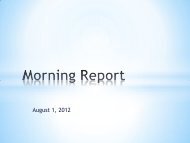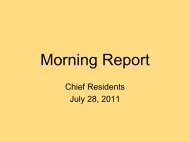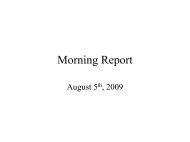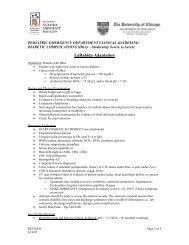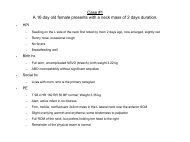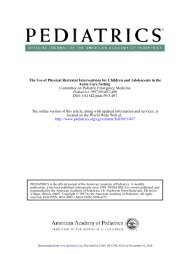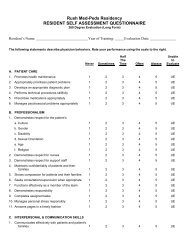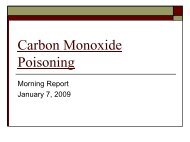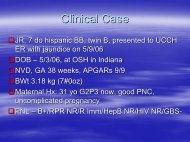Morning Report Case Presentation - Department of Pediatrics
Morning Report Case Presentation - Department of Pediatrics
Morning Report Case Presentation - Department of Pediatrics
Create successful ePaper yourself
Turn your PDF publications into a flip-book with our unique Google optimized e-Paper software.
<strong>Morning</strong> <strong>Report</strong> <strong>Case</strong><br />
<strong>Presentation</strong><br />
Adriana M. Orozco, M.D., F.A.A.P<br />
<strong>Department</strong> <strong>of</strong> Pediatric Emergency<br />
Medicine<br />
Sept. 19, 2005
History <strong>of</strong> Present Illness<br />
• GS is a 4 yr. old Hispanic male who was transferred to<br />
the U <strong>of</strong> C pediatric ER for evaluation <strong>of</strong> an episode <strong>of</strong><br />
gagging and foaming at the mouth. Parents stated<br />
episode lasted approx. 30 minutes . They denied apnea,<br />
jerking movements, stiffness, but stated he appeared<br />
limp.<br />
• +URI symptoms 2 weeks ago<br />
• +vomiting,- diarrhea, fever, rashes<br />
• -trauma<br />
• Pt. had similar episode 1 year ago – no work up done
Past Medical History<br />
• Birth history<br />
– Ex 37 weeker BW7# 3 day stay for oxygen therapy no intubation<br />
• Medical Illnesses<br />
– None except for previous episode <strong>of</strong> “gagging and foaming at mouth” 1 year ago<br />
• Surgical history<br />
– none<br />
• Immunizations<br />
– Up to date<br />
• Family Medical History<br />
– No asthma, seizures, apnea (SIDS),<br />
• Social History<br />
– Lives with parents and maternal uncle<br />
– Stays at home with mother- no daycare<br />
– Recent travel to Mexico
Physical Examination<br />
• T = 37.9, P= 110, RR=<br />
18, BP= 100/62<br />
• O2sat= 98% RA<br />
• HEENT: PERRL,EOMI,<br />
no nystagmus, TM’s nl ,<br />
OP nl<br />
• CV:RRR nl s1s2<br />
• RESP: CTA bilaterally<br />
• ABD: s<strong>of</strong>t, NT/ND +BS<br />
• GU: Testicles nl<br />
• Skin: no rashes<br />
• Neuro: Alert and oriented<br />
Moves all 4 extremities<br />
CN II- XII intact Muscle<br />
strength 5/5 bilaterally in<br />
upper and lower extrem.<br />
DTR 2+ bilaterally with<br />
down going toes nl<br />
coordination and gait
• CBC - normal<br />
• CMP - normal<br />
Labs<br />
• Urine toxicology screen – negative<br />
• CSF studies<br />
• Serologic studies
• CT<br />
•MRI<br />
•CXR<br />
Radiographic Studies
CT/GS
CXR/GS
MRI /GS
Additional Studies/Consults<br />
•EKG<br />
•EEG<br />
• Ophthamologic evaluation
Neurocysticercosis<br />
• Approximately 50 million people are thought to have<br />
cysticercosis worldwide<br />
• Cysticercosis is endemic in many countries, particularly<br />
Mexico, Central and South America, sub-Saharan Africa,<br />
and Asia.<br />
• <strong>Case</strong>s are seen in nonendemic countries, particularly<br />
those that have significant numbers <strong>of</strong> immigrants from<br />
endemic areas.<br />
• 76 cases <strong>of</strong> US acquired NC were reported throughout<br />
the country<br />
• 10% <strong>of</strong> patients presenting to the ER in LA with seizures<br />
had NC
Transmission <strong>of</strong> Neurocysticercosis<br />
• Humans develop NC via:<br />
– Ingestion <strong>of</strong> undercooked pork<br />
– Ingestion <strong>of</strong> T. solium eggs (most common)<br />
• In NC, tapeworm embryos are liberated<br />
from the eggs in the intestine, enter the<br />
bloodstream and are then carried to<br />
distant sites.<br />
• Most common sites involved are the brain,<br />
subcutaneous tissues, muscles, and eyes.
Transmission <strong>of</strong> Neurocysticercosis<br />
cont’d<br />
• Full maturation <strong>of</strong> the cyst takes 3-4 months<br />
• Size varies between 2-4mm to 2 cm in diameter<br />
• Cyst contains fluid and the scolex<br />
• As the cyst begins to die, an inflammatory<br />
reaction occurs (it is at this time that imaging<br />
studies show ring enhancement with edema<br />
around the cyst). This is then followed by a<br />
granular nodular stage and a final calcification<br />
stage.
Clinical Manifestations <strong>of</strong><br />
Neurocysticercosis<br />
• Depend on the location and number <strong>of</strong><br />
cysts<br />
• The timing <strong>of</strong> symptoms is usually 5-7<br />
years post infection but the range is 6<br />
months – 30 years.<br />
• Clinical syndromes divided into NC and<br />
extraneural manifestations<br />
• NC is further classified into parenchymal<br />
and extraparenchymal infection
Clinical Manifestations <strong>of</strong><br />
Neurocysticercosis<br />
•Seizures<br />
• Severe headaches<br />
• Nausea and vomiting (signs <strong>of</strong> increased<br />
ICP)<br />
• Mental deterioration<br />
• Psychiatric symptoms<br />
• Spinal cord involvement in 5% <strong>of</strong> NC<br />
– Radiating pain, paresis, impotence,<br />
neurogenic bladder, and CSF block
Diagnosis <strong>of</strong> Neurocysticercosis<br />
• CT – more sensitive for the detection <strong>of</strong> small<br />
calcifications and is less expensive than MRI<br />
• MRI – preferred over CT since it is more<br />
sensitive in detecting small lesions (brainstem or<br />
intraventricular) and is better at visualizing the<br />
scolex. MRI is more useful in evaluating<br />
degenerative changes in the parasite.<br />
• Serology - ELISA blot for the detection <strong>of</strong><br />
anticysticercal antibodies is the preferred<br />
serologic test ( sensitivity is 94% and specificity<br />
is almost 100%) but is <strong>of</strong>ten negative in cases<br />
with a single intracerebral lesion (kids).
Treatment <strong>of</strong> Neurocysticercosis<br />
• Anticonvulsants<br />
– Carbamazepine or phenytoin<br />
• Antiparasitic agents<br />
– Albendazole or praziquantel<br />
• Steroids<br />
– dexamethasone<br />
• Surgery



